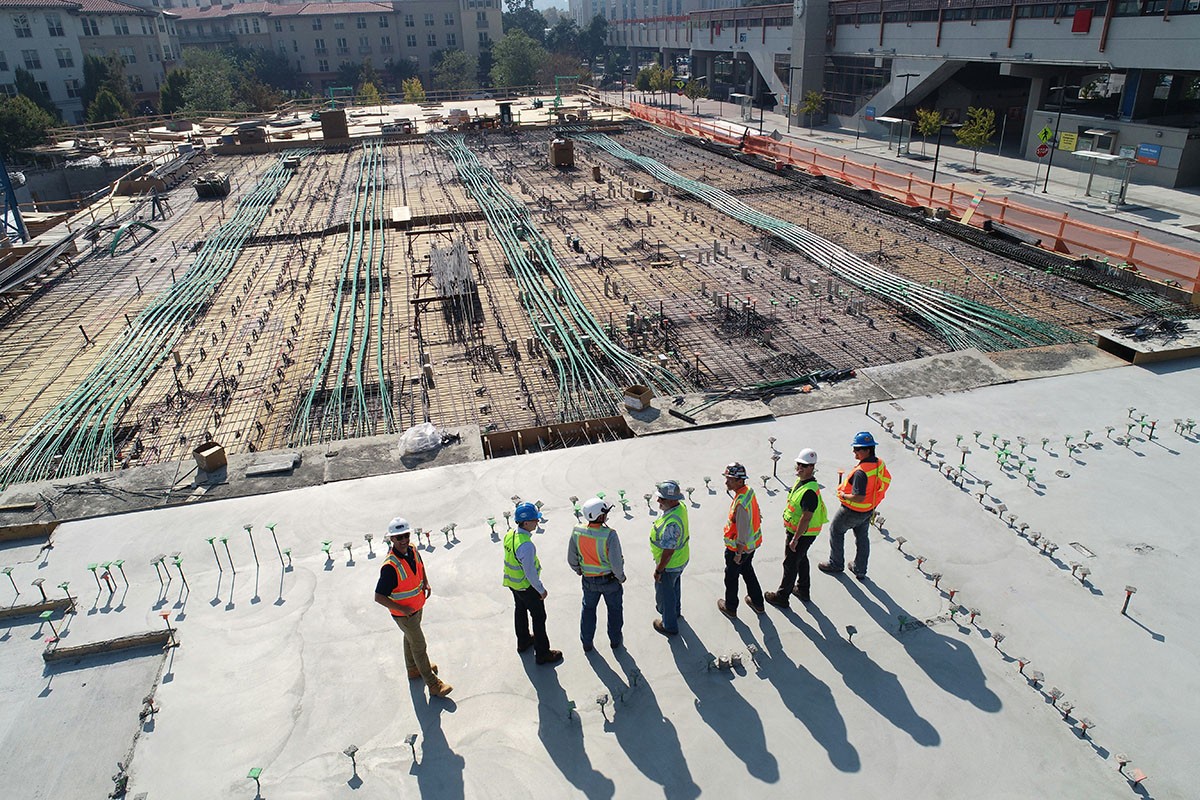- 23 January 2024
- No Comment
- 1003
The 10 Game-Changing Technologies in Construction

The question arises: what fueled this remarkable progress?
The answer lies in the industry’s openness to sustainable growth and the integration of new technologies into construction practices.
Driving the industry’s upward trajectory are pivotal developments, including advancements in construction methods, innovations in technology and software, prevalent market conditions, and legislative participation in the integration of new construction technologies.
According to insights from the 2022 CIArb Webinar report, the global construction market is poised to witness a staggering $8 trillion growth by 2030, with China, the U.S., and India leading the way.
Another study, the Global Construction 2030, anticipates an 85 percent increase in construction output volume, reaching $15.5 trillion worldwide by 2030.
Notably, China, the U.S., and India are expected to contribute to 57 percent of this global growth.
The integration of construction software and innovative technologies spans all phases of construction, from project initiation to on-site activities and the completion stage.
AEC (architecture, engineering, and construction) professionals widely use construction software, playing a crucial role in managing projects, from scheduling and planning to estimating, design, and facility management.
10 Emerging Construction Technologies
-
Virtual and Augmented Reality (VR/AR)
Among the cutting-edge construction technologies, virtual and augmented reality stand out as transformative innovations, offering immersive visualizations.
With the projected $8 trillion expansion of the global construction industry by 2030, the adoption of VR and AR is expected to play a pivotal role.
Anticipating a substantial 90 percent reduction in building costs, the implementation of AR/VR technology in 2022 has already made its mark in remote site inspections.
Beyond cost-effectiveness, it also enhances safety, facilitates collaboration, and improves communication among architecture, engineering, and construction (AEC) professionals.
-
5D BIM in Construction
Building Information Modeling (BIM) serves as a digital representation encapsulating both the physical and functional attributes of a building.
This comprehensive model becomes a dependable foundation for decision-making throughout a building’s entire life cycle, spanning from initial conception to eventual demolition.
BIM goes beyond the conventional three spatial dimensions, encompassing width, height, and depth. It extends into the fourth dimension (4D BIM), incorporating time, and further advances into the fifth dimension (5D BIM), integrating cost considerations.
Additionally, BIM addresses aspects such as asset management, sustainability, and more, making it a robust and holistic tool for optimizing construction processes and informed decision-making across various dimensions.
Presently, BIM is playing a pivotal role in fostering collaborative processes across the entire lifecycle of a built asset. From the initial planning stages through construction and continuing into its operational life, it empowers builders with comprehensive insights and efficient workflows.
-
3D Laser Scanner in the AEC Industry
One of the latest advancements in the Architecture, Engineering, and Construction (AEC) industry is the 3D laser scanner, a technology that continually evolves with yearly updates, ensuring its perpetual freshness.
Renowned for its capability to scan and analyze real-world objects, this innovation has found versatile applications in on-site surveying, mapping, project inspection, safety assessments, and various other construction-related tasks.
The 3D laser scanner’s interoperability and constant enhancements contribute to its reputation as a consistently innovative tool. Its remarkable accuracy plays a pivotal role in simplifying construction planning, leading to substantial cost savings.
Use Case
A notable example of the practical application of this technology is evident at the Aiguilles-Queyras Hospital Center, situated in the French Alps.
A 3D laser scanner of the FARO brand was employed in conjunction with Scan-BIM by ATFF to capture every feature of the existing hospital meticulously.
This comprehensive data was then utilized to generate a new model for the renovation project, showcasing the practicality and effectiveness of 3D laser scanners in real-world construction scenarios.
-
4D Simulation in Construction
In the relentless pursuit of optimization within the construction industry, 4D simulations have emerged as one of the latest technical solutions, offering time and cost-saving benefits for both onsite and offsite projects.
Use Case
A notable example of the practical application of 4D simulation is evident in the Haweswater Aqueduct’s Bentley pipeline project by the Mott MacDonald company.
By incorporating 4D simulation, the company realized significant efficiency gains, saving a remarkable 20 days in the project timeline. This underscores the tangible benefits of 4D simulations in delivering substantial time and cost efficiencies in real-world construction endeavors.
-
3D Printing in Construction
3D printing stands out as one of the latest technologies making waves in the construction industry.
Its unique process involves constructing three-dimensional buildings from digital models, with its inception dating back to 1995. In the current trend of 2024, creating 3D models through specialized 3D software programs has become increasingly prevalent.
Use Cases
The versatility of 3D printing is exemplified in various use cases. Engineers at Arup harnessed 3D printing technology to fabricate steel nodes for a lightweight structure, showcasing the adaptability of this innovative approach.
Additionally, the Shanghai-based firm Win Sun Decoration Design Engineering applied 3D printing to spray a mixture of quick-drying cement and recycled raw materials, highlighting the technology’s potential for sustainable and efficient construction practices.
-
Robotics in Construction
In response to the ongoing labor shortages confronting the global construction industry, robots are becoming increasingly prevalent on construction sites.
Builders are actively exploring ways to integrate robotics to address workforce challenges effectively.
The incorporation of robotics enables the automation of repetitive tasks like bricklaying and rebar tying, tasks that robots can execute with precision and efficiency. This strategic use of robotics not only streamlines construction processes but also alleviates workers from the burden of monotonous and repetitive work.
One notable advantage of employing robots in construction is their ability to operate continuously without breaks. This translates to accelerated construction timelines, surpassing what can be achieved by human workers.
The introduction of robotics is thus poised to revolutionize construction methodologies, enhancing efficiency and productivity on construction sites globally.
-
Drones in Construction
The integration of drones into construction practices has been a continuous trend for over a decade. As we move into 2024 and beyond, the industry is poised to witness the emergence of even more advanced drones, incorporating sophisticated artificial intelligence (AI) capabilities.
Drones are reshaping construction methodologies by providing real-time aerial imagery and executing 3D lidar scans.
Anticipate heightened interoperability, particularly with the Scan to BIM mode on drones, facilitating the instantaneous sharing of construction data with other Building Information Modeling (BIM) platforms.
This seamless exchange is expected to occur in microseconds, streamlining collaboration and data integration across diverse BIM-based systems.
-
Blockchain Technology in Construction
As we look ahead to 2024 and beyond, the entire Architecture, Engineering, and Construction (AEC) industry is poised to experience enhanced cost management and streamlined procurement strategies through the integration of blockchain technology.
Just over a decade ago, this groundbreaking technology made its debut in construction, presenting itself as interconnected sets of data “blocks” forming a digital ledger.
This ledger meticulously records all transactions and completed milestones, akin to the links in a chain, automatically maintaining balance.
Unlike conventional methods, blockchain technology offers a secure, decentralized, and adaptable solution applicable to projects of any scale.
Its safety and adaptability make it a standout choice in the construction landscape, providing an efficient and transparent framework for managing costs and optimizing procurement strategies.
-
Digital Twin in the AEC Industry
Addressing operational management challenges, the digital twin stands out as the latest technology in the Architecture, Engineering, and Construction (AEC) industry.
This innovative approach involves employing simulation techniques to create a virtual prototype of a building. The trends and functionality of digital twins encompass the utilization of intelligent multidimensional digital models.
Looking ahead to 2024 and beyond, we can expect a reduction in buildings facing operational issues, all thanks to the capabilities of digital twins. These technological marvels simulate, predict, and provide informed decisions based on real-world conditions, ensuring fewer challenges in the operational phase.
Digital twins conduct performance analyses by considering occupants’ behaviors, utilizing patterns and spatial considerations to enhance overall efficiency.
-
Offsite Construction: A Rapidly Growing Construction Technology Trend
Offsite construction stands out as one of the most rapidly growing trends in construction technology.
This innovative approach involves crafting building components within a controlled factory environment and subsequently transporting them to the construction site for final assembly.
One notable advantage of offsite construction is its contribution to minimizing the waste of building materials and promoting sustainability in the building process.
Beyond waste reduction, this method offers additional benefits such as enhanced quality control and shortened construction timelines.
The precision achievable in design and assembly through offsite construction results in superior-quality finished products.
However, it’s important to note that this technique demands specific and highly trained construction workers, potentially affecting its adoption rate among smaller-scale builders due to the specialized skill requirements.
As the construction industry continues to embrace innovation, the journey towards creating smarter, greener, and more connected built environments accelerates, setting the stage for a future where construction is not just about erecting structures but about building a sustainable and harmonious world for generations to come.
#ConstructionTechnologyTrends #InnovativeConstructionMethods #SustainableConstruction #OffsiteConstruction #3DPrintingInConstruction #RoboticsInBuilding #ConstructionIndustryInnovations #SmartConstructionTech #FutureOfConstruction #TopConstructionInnovations
